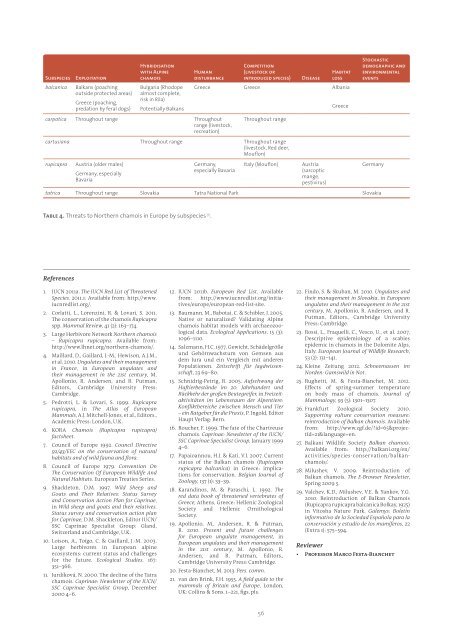130925-studie-wildlife-comeback-in-europe
You also want an ePaper? Increase the reach of your titles
YUMPU automatically turns print PDFs into web optimized ePapers that Google loves.
Subspecies<br />
balcanica<br />
Exploitation<br />
Balkans (poach<strong>in</strong>g<br />
outside protected areas)<br />
Greece (poach<strong>in</strong>g,<br />
predation by feral dogs)<br />
Hybridisation<br />
with Alp<strong>in</strong>e<br />
chamois<br />
Bulgaria (Rhodope<br />
almost complete,<br />
risk <strong>in</strong> Rila)<br />
Potentially Balkans<br />
carpatica Throughout range Throughout<br />
range (livestock,<br />
recreation)<br />
Human<br />
disturbance<br />
Competition<br />
(livestock or<br />
<strong>in</strong>troduced species) Disease<br />
Habitat<br />
loss<br />
Greece Greece Albania<br />
Throughout range<br />
cartusiana Throughout range Throughout range<br />
(livestock, Red deer,<br />
Mouflon)<br />
rupicapra<br />
Austria (older males)<br />
Germany, especially<br />
Bavaria<br />
Germany,<br />
especially Bavaria<br />
Italy (Mouflon)<br />
Austria<br />
(sarcoptic<br />
mange,<br />
pestivirus)<br />
Greece<br />
Stochastic<br />
demographic and<br />
environmental<br />
events<br />
Germany<br />
tatrica Throughout range Slovakia Tatra National Park Slovakia<br />
Table 4. Threats to Northern chamois <strong>in</strong> Europe by subspecies [1] .<br />
References<br />
1. IUCN 2011a. The IUCN Red List of Threatened<br />
Species. 2011.1: Available from: http://www.<br />
iucnredlist.org/.<br />
2. Corlatti, L., Lorenz<strong>in</strong>i, R. & Lovari, S. 2011.<br />
The conservation of the chamois Rupicapra<br />
spp. Mammal Review, 41 (2): 163–174.<br />
3. Large Herbivore Network Northern chamois<br />
– Rupicapra rupicapra. Available from:<br />
http://www.lhnet.org/northern-chamois/.<br />
4. Maillard, D., Gaillard, J.-M., Hewison, A.J.M.,<br />
et al. 2010. Ungulates and their management<br />
<strong>in</strong> France, <strong>in</strong> European ungulates and<br />
their management <strong>in</strong> the 21st century, M.<br />
Apollonio, R. Andersen, and R. Putman,<br />
Editors., Cambridge University Press:<br />
Cambridge.<br />
5. Pedrotti, L. & Lovari, S. 1999. Rupicapra<br />
rupicapra, <strong>in</strong> The Atlas of European<br />
Mammals, A.J. Mitchell-Jones, et al., Editors.,<br />
Academic Press: London, U.K.<br />
6. KORA Chamois (Rupicapra rupicapra)<br />
factsheet.<br />
7. Council of Europe 1992. Council Directive<br />
92/43/EEC on the conservation of natural<br />
habitats and of wild fauna and flora.<br />
8. Council of Europe 1979. Convention On<br />
The Conservation Of European Wildlife And<br />
Natural Habitats. European Treaties Series.<br />
9. Shackleton, D.M. 1997. Wild Sheep and<br />
Goats and Their Relatives: Status Survey<br />
and Conservation Action Plan for Capr<strong>in</strong>ae,<br />
<strong>in</strong> Wild sheep and goats and their relatives.<br />
Status survey and conservation action plan<br />
for Capr<strong>in</strong>ae, D.M. Shackleton, Editor IUCN/<br />
SSC Capr<strong>in</strong>ae Specialist Group: Gland,<br />
Switzerland and Cambridge, U.K.<br />
10. Loison, A., Toïgo, C. & Gaillard, J.-M. 2003.<br />
Large herbivores <strong>in</strong> European alp<strong>in</strong>e<br />
ecosystems: current status and challenges<br />
for the future. Ecological Studies, 167:<br />
351–366.<br />
11. Jurdíková, N. 2000. The decl<strong>in</strong>e of the Tatra<br />
chamois. Capr<strong>in</strong>ae: Newsletter of the IUCN/<br />
SSC Capr<strong>in</strong>ae Specialist Group, December<br />
2000 4–6.<br />
12. IUCN 2011b. European Red List. Available<br />
from: http://www.iucnredlist.org/<strong>in</strong>itiatives/<strong>europe</strong>/<strong>europe</strong>an-red-list-site.<br />
13. Baumann, M., Babotai, C. & Schibler, J. 2005.<br />
Native or naturalized? Validat<strong>in</strong>g Alp<strong>in</strong>e<br />
chamois habitat models with archaeozoological<br />
data. Ecological Applications, 15 (3):<br />
1096–1110.<br />
14. Salzmann, H.C. 1977. Gewicht, Schädelgröße<br />
und Gehörnwachstum von Gemsen aus<br />
dem Jura und e<strong>in</strong> Vergleich mit anderen<br />
Populationen. Zeitschrift für Jagdwissenschaft,<br />
23 69–80.<br />
15. Schnidrig-Petrig, R. 2005. Aufschwung der<br />
Huftierbestände im 20. Jahrhundert und<br />
Rückkehr der großen Beutegreifer, <strong>in</strong> Freizeitaktivitäten<br />
im Lebensraum der Alpentiere:<br />
Konfliktbereiche zwischen Mensch und Tier<br />
– e<strong>in</strong> Ratgeber für die Praxis, P. Ingold, Editor<br />
Haupt Verlag: Bern.<br />
16. Roucher, F. 1999. The fate of the Chartreuse<br />
chamois. Capr<strong>in</strong>ae: Newsletter of the IUCN/<br />
SSC Capr<strong>in</strong>ae Specialist Group, January 1999<br />
4–6.<br />
17. Papaioannou, H.I. & Kati, V.I. 2007. Current<br />
status of the Balkan chamois (Rupicapra<br />
rupicapra balcanica) <strong>in</strong> Greece: implications<br />
for conservation. Belgian Journal of<br />
Zoology, 137 (1): 33–39.<br />
18. Karand<strong>in</strong>os, M. & Paraschi, L. 1992. The<br />
red data book of threatened vertebrates of<br />
Greece, Athens, Greece: Hellenic Zoological<br />
Society and Hellenic Ornithological<br />
Society.<br />
19. Apollonio, M., Andersen, R. & Putman,<br />
R. 2010. Present and future challenges<br />
for European ungulate management, <strong>in</strong><br />
European ungulates and their management<br />
<strong>in</strong> the 21st century, M. Apollonio, R.<br />
Andersen, and R. Putman, Editors.,<br />
Cambridge University Press: Cambridge.<br />
20. Festa-Bianchet, M. 2013. Pers. comm.<br />
21. van den Br<strong>in</strong>k, F.H. 1955. A field guide to the<br />
mammals of Brita<strong>in</strong> and Europe, London,<br />
UK: Coll<strong>in</strong>s & Sons. 1–221, figs, pls.<br />
22. F<strong>in</strong>do, S. & Skuban, M. 2010. Ungulates and<br />
their management <strong>in</strong> Slovakia, <strong>in</strong> European<br />
ungulates and their management <strong>in</strong> the 21st<br />
century, M. Apollonio, R. Andersen, and R.<br />
Putman, Editors., Cambridge University<br />
Press: Cambridge.<br />
23. Rossi, L., Fraquelli, C., Vesco, U., et al. 2007.<br />
Descriptive epidemiology of a scabies<br />
epidemic <strong>in</strong> chamois <strong>in</strong> the Dolomite Alps,<br />
Italy. European Journal of Wildlife Research,<br />
53 (2): 131–141.<br />
24. Kle<strong>in</strong>e Zeitung 2012. Schneemassen im<br />
Norden: Gamswild <strong>in</strong> Not.<br />
25. Rughetti, M. & Festa-Bianchet, M. 2012.<br />
Effects of spr<strong>in</strong>g-summer temperature<br />
on body mass of chamois. Journal of<br />
Mammalogy, 93 (5): 1301–1307.<br />
26. Frankfurt Zoological Society 2010.<br />
Support<strong>in</strong>g vulture conservation measure:<br />
re<strong>in</strong>troduction of Balkan chamois. Available<br />
from: http://www.zgf.de/?id=65&projectId=21&language=en.<br />
27. Balkani Wildlife Society Balkan chamois.<br />
Available from: http://balkani.org/en/<br />
activities/species-conservation/balkanchamois/.<br />
28. Milushev, V. 2009. Re<strong>in</strong>troduction of<br />
Balkan chamois. The E-Browser Newsletter,<br />
Spr<strong>in</strong>g 2009 5.<br />
29. Valchev, K.D., Milushev, V.E. & Yankov, Y.G.<br />
2010. Re<strong>in</strong>troduction of Balkan Chamois<br />
(Rupicapra rupicapra balcanica Bolkay, 1925)<br />
<strong>in</strong> Vitosha Nature Park. Galemys: Boletín<br />
<strong>in</strong>formativo de la Sociedad Española para la<br />
conservación y estudio de los mamíferos, 22<br />
(Extra 1): 575–594.<br />
Reviewer<br />
• Professor Marco Festa-Bianchet<br />
56


